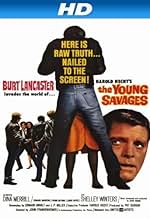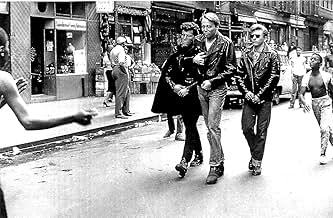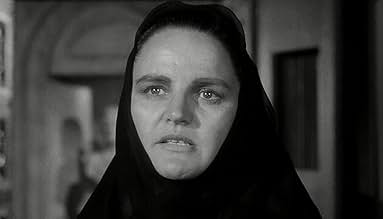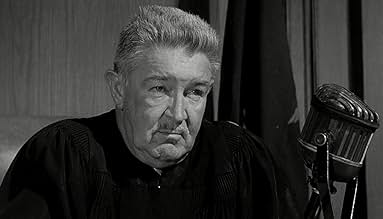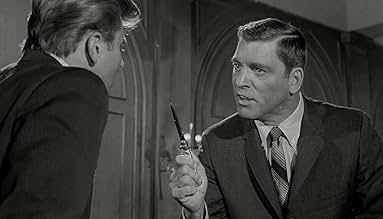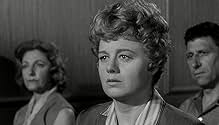IMDb RATING
6.9/10
3.1K
YOUR RATING
A district attorney investigates three white teenagers accused of murdering a blind Puerto Rican kid.A district attorney investigates three white teenagers accused of murdering a blind Puerto Rican kid.A district attorney investigates three white teenagers accused of murdering a blind Puerto Rican kid.
Neil Burstyn
- Anthony 'Batman' Aposto
- (as Neil Nephew)
José Pérez
- Roberto Escalante
- (as Jose Perez)
- Director
- Writers
- All cast & crew
- Production, box office & more at IMDbPro
Featured review
The Young Savages (1961)
Released six months before "West Side Story," this elegant story of New York gang violence in the ghettos of uptown Manhattan is as powerful, and as beautiful. And the title makes clear that the movie is pointing to a new social problem, the immigrant gangs (Italian and Puerto Rican in this case). But in most ways "The Young Savages" couldn't be more different.
At the heart of it all is district attorney Hank Bell, previously Bellini, played by Burt Lancaster in what struck me as possibly the most subtle role in his career. That's an absurd thing to know for sure, and Lancaster is so good so often it's easier to just say he is terrific, but if you know him from some noir films or from "Birdman of Alcatraz" or "Judgement at Nuremberg" you might know a more overtly dramatic actor. Here he is restrained in a perfect way, his pauses and his turned head adding depth to his apparent struggle with how to get at the truth as the events and the witnesses start to swirl out of control. A virtuosic performance.
The themes are hot topic issues layered with good old fashioned love and loyalty. Mostly we have first and second generation immigrant trying to define themselves, to stake out a place in the city, and to fend off competing immigrant groups and sometimes invade their territory. Bell's own Italian-American background makes him understand the problems of youth violence from the inside, but he has avoided being identified as Italian, and even his wife doesn't quite accept him as an immigrant, but wants to see him as more like her, a Vassar girl. Which he is not, even if sometimes he passes as a Yankee or as an old stock New Yorker.
Much of the movie is that wonderful quite and deliberate investigation of the crime, the facts, the witnesses, the evidence. And we see this through Bell's eyes. The last long section is pure courtroom drama, and it's as good as courtroom dramas get, gutsy and tense. In the biggest sense, real justice is achieved, even at the expense of some reputations or expectations around the D.A. (who of course is supposed to always want and get the death penalty). By the final turns of events, you see the story is really about a single man who struggles against his own bias and does the right thing, and does it well. Director John Frankenheimer once again pulls off a movie with social significance that doesn't forget it's roots in theatrical drama.
Cinematographer Lionel Lindon is an old pro, starting with some 1940s boilerplate movies sprinkled with some gems ("The Blue Dahlia" is a great one) and then scores of television shows. And the next year, 1962, he shot "The Manchurian Candidate" which succeeds partly for its amazing visual pizazz. Here, there are both moments of beauty and of cacophony. The fight scenes, and the dazzling murder that starts the movie off, are mini-masterpieces. But even quiet moments are given anxiety and drama by shooting at sharp angles or by moving in close. It's quite a beautiful experience to watch this, even as the events are tumultuous.
Released six months before "West Side Story," this elegant story of New York gang violence in the ghettos of uptown Manhattan is as powerful, and as beautiful. And the title makes clear that the movie is pointing to a new social problem, the immigrant gangs (Italian and Puerto Rican in this case). But in most ways "The Young Savages" couldn't be more different.
At the heart of it all is district attorney Hank Bell, previously Bellini, played by Burt Lancaster in what struck me as possibly the most subtle role in his career. That's an absurd thing to know for sure, and Lancaster is so good so often it's easier to just say he is terrific, but if you know him from some noir films or from "Birdman of Alcatraz" or "Judgement at Nuremberg" you might know a more overtly dramatic actor. Here he is restrained in a perfect way, his pauses and his turned head adding depth to his apparent struggle with how to get at the truth as the events and the witnesses start to swirl out of control. A virtuosic performance.
The themes are hot topic issues layered with good old fashioned love and loyalty. Mostly we have first and second generation immigrant trying to define themselves, to stake out a place in the city, and to fend off competing immigrant groups and sometimes invade their territory. Bell's own Italian-American background makes him understand the problems of youth violence from the inside, but he has avoided being identified as Italian, and even his wife doesn't quite accept him as an immigrant, but wants to see him as more like her, a Vassar girl. Which he is not, even if sometimes he passes as a Yankee or as an old stock New Yorker.
Much of the movie is that wonderful quite and deliberate investigation of the crime, the facts, the witnesses, the evidence. And we see this through Bell's eyes. The last long section is pure courtroom drama, and it's as good as courtroom dramas get, gutsy and tense. In the biggest sense, real justice is achieved, even at the expense of some reputations or expectations around the D.A. (who of course is supposed to always want and get the death penalty). By the final turns of events, you see the story is really about a single man who struggles against his own bias and does the right thing, and does it well. Director John Frankenheimer once again pulls off a movie with social significance that doesn't forget it's roots in theatrical drama.
Cinematographer Lionel Lindon is an old pro, starting with some 1940s boilerplate movies sprinkled with some gems ("The Blue Dahlia" is a great one) and then scores of television shows. And the next year, 1962, he shot "The Manchurian Candidate" which succeeds partly for its amazing visual pizazz. Here, there are both moments of beauty and of cacophony. The fight scenes, and the dazzling murder that starts the movie off, are mini-masterpieces. But even quiet moments are given anxiety and drama by shooting at sharp angles or by moving in close. It's quite a beautiful experience to watch this, even as the events are tumultuous.
- secondtake
- Apr 12, 2011
- Permalink
Storyline
Did you know
- TriviaDuring the commentary she did for the DVD of What Makes Sammy Run?: Part 1 (1959) Dina Merrill said that the treatment she received from director John Frankenheimer on this picture nearly drove her out of the business. He told her at the end of a day's filming that she was the worst actress he'd ever worked with. She said she went home in tears. It got so bad that her co-star Burt Lancaster came to her defense one morning by ridiculing the director's "good mood" as evidenced by the fact that he hadn't insulted Dina yet.
- GoofsAfter Hank Bell is attacked by the gang in the subway car, the next shot opens with the doctor in the emergency room examining a chest x-ray that is obviously reversed.
- Quotes
Danny diPace: Don't con me Mr. Bell. Bell! Your name's Bellini, and you're a wop just like me! What's a-matter, Mr Bellini, you're ashamed of being a wop?
- How long is The Young Savages?Powered by Alexa
Details
- Release date
- Country of origin
- Languages
- Also known as
- The Young Savages
- Filming locations
- Fulton Fishmarket, Fulton Street, Manhattan, New York City, New York, USA(Bell and Gunderson go to see Angela and her father who works there)
- Production company
- See more company credits at IMDbPro
- Runtime1 hour 43 minutes
- Color
- Aspect ratio
- 1.85 : 1
Contribute to this page
Suggest an edit or add missing content




















